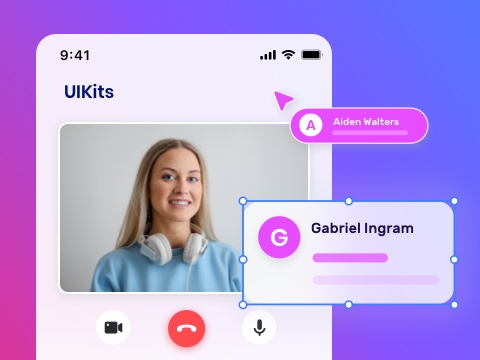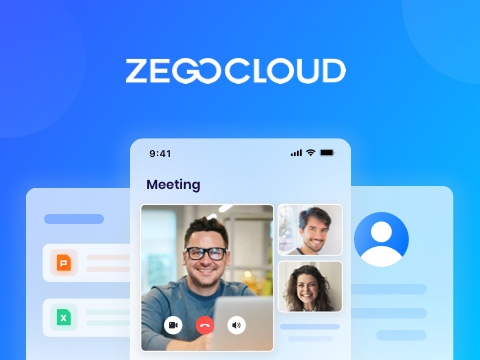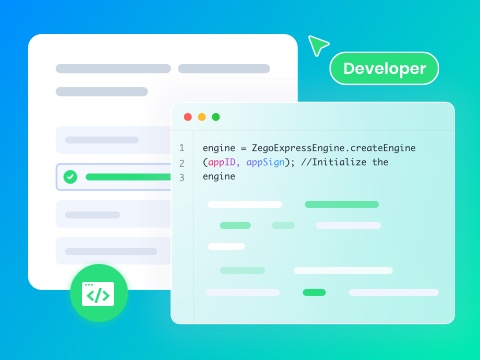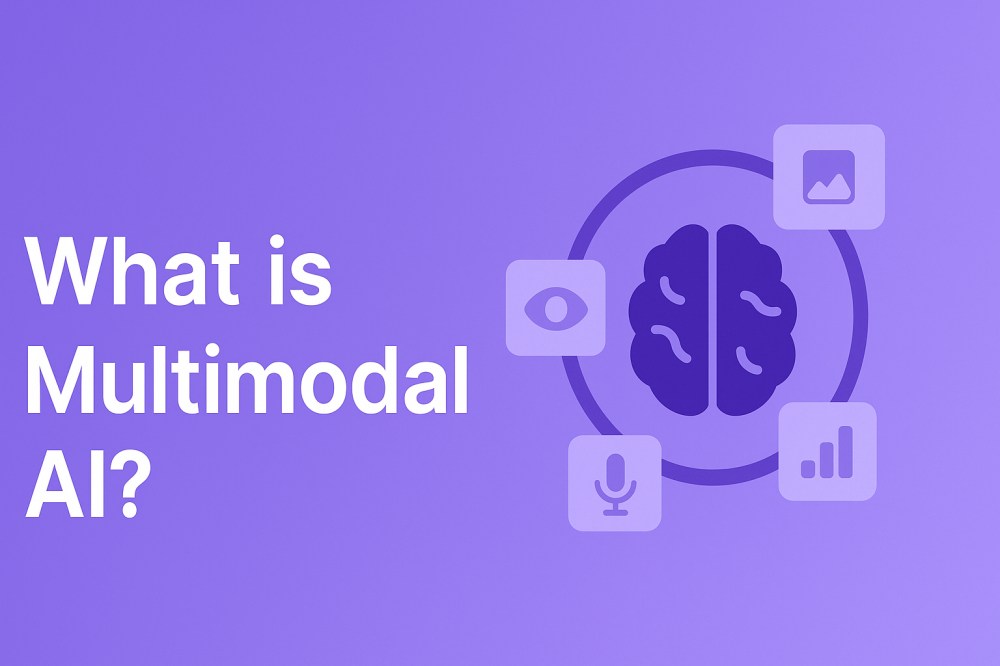Many AI systems today only focus on one type of data, which limits their understanding. This happens because most of these models are built for specific tasks like researching or providing support. Multimodal AI changes this system by understanding and combining data from multiple sources. This article will discuss this type of AI in detail and explain why it matters and how it differs from others.
What is Multimodal AI?
It is a type of artificial intelligence that understands and processes different types of modalities together using machine learning. Instead of learning from only one source, it learns from many, such as text and media. The multimodal definition explains that it uses deep learning and neural networks along with transformers to combine and analyze all inputs. Unlike regular models, it can understand sounds and read text in images.
Consequently, it provides more context-aware answers and insights about complex queries and reasoning. Similarly, it uses convolutional neural networks (CNNs) for visual data and transformers for language inputs. These systems also rely on fusion techniques to combine multiple inputs into a shared representation.
Why Multimodal AI Matters?
Once you know the importance of this modal AI system, it will become easier to understand and utilize it. That’s why the following section explains why multimodal artificial intelligence systems matter:
- Better Understanding: Since it combines different data types, such as media and text, to better understand the problem, this AI system handles real-life problems better. In short, these systems understand the full environment instead of just one piece of information.
- Improved User Experience: You can create apps that react to speech and gestures at the same time with this technology. Consequently, it results in smarter and more natural communication with devices.
- Stronger Decision Making: AI can detect errors and verify data using multiple sources by merging inputs across different modalities. Transformer architectures like FLAVA or Perceiver IO support these decision layers using joint embedding spaces.
- Flexible Deployment: You can use multimodal models in various industries, such as healthcare and security, that ensure human safety. These applications rely on aligned modality processing and shared feature maps across data.
- Accessibility Tools: Using decoder models and modality transformers with LLMs, these systems convert audio into captions or summarize videos. Hence, they provide many useful accessibility tools to help people with visual or hearing impairments.
How Does Multimodal AI Differ from Other AI?
Apart from better contextual understanding, these multi-modal AI systems have many obvious differences from simple AI models. Therefore, the following table explains these differences in a better way to help you understand why multimodal is better:
| Feature | Traditional AI | Multimodal AI |
|---|---|---|
| Data Input | One type (text, image, or audio) | Multiple types (text, image, video, audio) |
| Technology Used | CNNs or transformers per task | Fusion of CNNs, LLMs, and RNNs with attention layers |
| Training Method | Trained on a single dataset | Requires aligned datasets from multiple sources |
| Use Cases | Spam filters and object detection | Chatbots, healthcare imaging, and education platforms. |
| Flexibility | Limited task performance | Adaptable across tasks and domains |
| System Design | Specific-function narrow models | Multi-function unified systems |
| Data Fusion | Not applicable | Early, mid, or late fusion techniques |
| Scalability | Easy to scale within the same data type | Requires complex architecture and large resources |
| Human Interaction | Relies on type commands | Supports voice, gesture, image, and text input |
| Efficiency | Fast with limited input types | Slower but more context-rich and accurate |
How Multimodal AI Works?
While learning what multimodality is, the most important part is to understand how it works, including its complete workflow. That’s why the following sections discuss the working of these multimodal systems:
1. Heterogeneity
Multimodal AI systems begin by recognizing that each input type, such as text or sound, has unique qualities and patterns, which are called heterogeneity. Here, engineers use specialized models, such as CNNs for image processing and RNNs to handle audio. These specific models extract important features from each modality separately. Afterward, feature vectors from each data stream are merged into shared layers for unified learning.
2. Connections
Connections refer to the shared meaning or patterns between modalities and are important to understanding what multimodal AI is. AI systems use embedding layers to create vector spaces where related data types exist closely together. Similarly, attention mechanisms and cross-modal encoders help identify overlap. Specifically, alignment tools match images with captions or audio with video frames to allow AI to understand relationships between inputs.
3. Interaction
Interaction means combining all inputs and processing them in relation to each other and not in isolation. Now, models like CLIP or Flamingo merge data in shared attention layers and allow one modality to influence another. Additionally, neural networks compute interactions across inputs to detect objects and answer questions. This interaction stage creates a fully integrated understanding, which allows modal AI to reason in real-world ways.
4. Fusion
Data fusion happens in three ways: from early to middle and then to late. Early fusion encodes all modalities into one shared input layer. Conversely, mid-fusion combines data after separate feature extraction stages. In the end, late fusion processes data through separate models and merges the final outputs. These approaches use shared embeddings and gating mechanisms to ensure that multi-modal AI systems can learn both individual and combined relationships.
5. Reasoning and Generation
Multimodal AI reasoning involves combining evidence from different inputs to answer questions or make decisions. The model performs multiple steps of inference across images and videos, and an advanced transformer architecture helps create logical connections between modalities. Generation goes one step further by allowing the model to create new content. Similarly, both reasoning and generation rely on well-aligned multimodal embeddings and deep fusion layers.
6. Transfer and Quantification
Transfer learning in multimodal models allows a model trained on one modality to apply its knowledge to another. Alternatively, quantification refers to evaluating performance, which is harder in such AI systems. Similarly, engineers use benchmark datasets and consistency tests to help identify weak points or biases. The goal is to create models that are not only smart but also reliable and explainable across different input types.
Trends in Multimodal AI
We can say that multi-modal AI systems are going to lead the race due to their advantages. They are widely used in different ways across industries, and the following sections explain a few trends involving these systems:
- AI Search Engines: This AI system is now powering search tools that understand voice and image input together. Consequently, users can search with photos and get descriptions without losing the context.
- Cross-Modal Generation: Models like DALL-E and Gemini can generate images from text or convert images into stories. These systems use fusion layers and transformer models for joint understanding and help different industries with limited input data.
- Virtual Assistants: VAs now use search and facial cues to improve communication and recognize emotional tone to respond in multiple ways.
- Multilingual AI: Researchers are combining language translation with multimodal inputs to support global applications. Similarly, this trend supports accessibility and inclusive design for international audiences.
- Robotics and Vision: Robotics now use multimodal AI vision to navigate and identify surroundings using cameras and microphones. They interpret environments more naturally by combining audio and video touches.
Technical Challenge of Multimodal AI
Although multimodal models present great benefits, there are many challenges that companies need to overcome to implement them. We have shared the common technical challenges that you might face when implementing these AI systems below:
- Complex Data Alignment: Aligning text and media across time and space requires precise syncing, which is hard to achieve. Thus, multimodal must learn relationships between inputs that don’t naturally occur at the same time or format.
- Representation Learning Difficulty: Creating shared representations across different data types is difficult because each modality has its own structure. Different data types require separate encoders, such as transformers and CNNs, for accurate understanding.
- Scarcity of Datasets: Training multimodal models needs large datasets where each input type is paired correctly, but these are very limited today. Many datasets lack proper alignment across modalities or suffer from privacy concerns that restrict free access.
- Reasoning Errors: Multimodal reasoning requires the model to connect clues across modalities, but misalignment leads to errors in understanding. Similarly, incorrect associations between voice and text can cause the system to generate false outputs.
- High Computing Costs: These models require enormous GPU power because they process multiple data types through parallel deep learning networks. Furthermore, training them includes a long runtime and large memory storage, which drives up infrastructure costs significantly.
How ZEGOCLOUD Powers Real-Time Multimodal AI Experiences
Since modal AI assistants rely on communication infrastructure to work properly, services like ZEGOCLOUD are highly useful in their creation. AI voice and chat assistants require low-latency communication layers to function properly, and this platform provides this with its real-time interactive AI agent. Its SDKs and server-side APIs support instant integration of text messaging and calling features to help create seamless humanized AI interactions.
For multimodal AI interactions, ZEGOCLOUD provides IM Chat with support for personal and group conversations with multiple AI agents. Similarly, memory integration ensures context-aware conversations as AI can recall past conversations for a personalized experience. Voice calls are equally advanced, with less than 1s response time and an interruption latency of around 500ms. Furthermore, it provides natural and humanized TTS vendors with a recognition accuracy of more than 95%.
To further enhance flexibility and intelligence in multimodal scenarios, ZEGOCLOUD AI Agent now supports Multi-LLM integration. Developers can connect to leading models such as ChatGPT, Qwen, MiniMax, and Doubao, enabling dynamic model selection based on region, latency, or task complexity. This unlocks more responsive and localized experiences in both chat and voice-based interactions, and allows fallback switching for greater reliability across global applications.
Digital humans represent the most immersive form of AI offered by ZEGOCLOUD, as they offer below 200ms latency. You can give it your image, and it can create a realistic avatar with humanized expressions and lip movements. Unlike competitors, it offers 20% higher clarity for 1080p digital human images for a more premium experience. It provides all these features while only costing 5% of what traditional solutions cost.
Conclusion
To conclude, multimodal AI systems are changing how machines understand and interact with the world by combining text and media into one powerful system. It uses deep learning, transformers, and fusion techniques to solve real-life tasks with more depth.
From chatbots to search engines and virtual assistants, multimodal AI is transforming every digital experience. Considering their dependency on communication infrastructure, ZEGOCLOUD is highly recommended to build and enhance them.
FAQ
Q1: What is the difference between generative AI and multimodal AI?
Generative AI refers to AI systems that can create new content, such as text, images, or music, based on learned data. It focuses on producing outputs like articles, code, or pictures.
Multimodal AI, on the other hand, can process and understand multiple types of input (e.g., text, voice, image) simultaneously. It may use generative AI techniques, but its key strength lies in combining different modes of information for a more human-like interaction.
Q2: Is ChatGPT a multimodal AI?
ChatGPT, by default, is a text-only generative AI. However, in certain implementations (like GPT-4 with vision), it can understand images and text, making it multimodal. When integrated with voice and image inputs, it supports more immersive user experiences.
Q3: What is unimodal vs multimodal AI?
Unimodal AI processes a single type of input (e.g., just text or just images). It’s limited in its contextual understanding across different sensory types.
Multimodal AI can interpret and combine multiple input types, such as text, speech, images, or video, making it more suitable for real-world applications like digital humans or voice assistants.
Q4: What is a multimodal AI agent?
A multimodal AI agent is an AI system capable of understanding and responding across multiple input and output formats—like reading text, listening to voice, analyzing images, and replying in speech or visuals. These agents are used in applications like smart tutors, virtual assistants, or AI companions, offering a more natural and interactive user experience.
Let’s Build APP Together
Start building with real-time video, voice & chat SDK for apps today!










